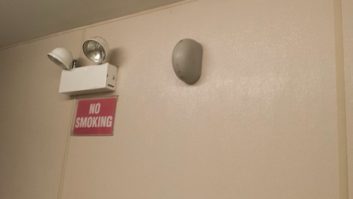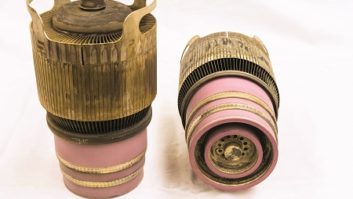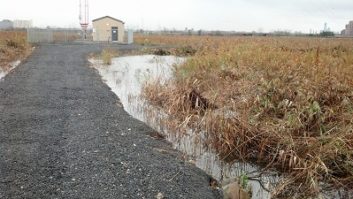Keeping the Copper Safe
Jun 1, 2013 7:00 AM, By Kevin McNamara
Recently I offered some tips on site security, particularly in light of the myriad of copper thefts occurring around the country, especially in copper rich environments like communications sites. The reality is, if someone wants copper, he will get it, if given enough time with no other people around. But the few dollars a thief might realize selling this material is nothing compared to the cost of damage repair, or more importantly the costs incurred should a station be taken off the air for any period of time.
While scrap copper is paying nearly $3 per pound, brass and some types of steel can bring about $2 per pound. As it turns out, we have a lot of these at typical broadcast transmitter sites.
Tampering with a licensed communication facility is a federal offense; however, I’m not aware of any time when the federal government was directly involved with this type of theft. It has primarily been handled by local law enforcement. Many police departments have a copper theft task force. They tend to have good intelligence on specific activities going on within their jurisdiction. It might be worth a call to see if they would be willing to meet at your facilities to evaluate the level of risk for theft and perhaps offer some advice on theft proofing these sites.
Co-located sites
Whether you share your transmitter site with other broadcasters and wireless tenants or lease space to wireless tenants on a company owned-tower, be aware that all combinations used on locks provided by wireless carriers are well known throughout the industry. Typically they daisy-chain their locks to others. Pretty much anyone with exposure to that industry has the cheat-sheet. In my experience, I have seen several sites sustain damage by a thief, but no indication of forced break-in. This suggests the job was done by someone with a little knowledge about the site. Along the same lines, be careful hiring new employees, as part of your hiring practice, consider running a criminal background check on all applicants. This may give you additional insight into a prospective employee.
It is almost impossible to eliminate exposed copper or other metals. Copper isn’t worth as much dirty as it is bare. Thieves usually don’t want to take the time to clean it. This also applies to jacked transmission lines; however, going back to my previous statement, someone on the inside would know that it’s easy to strip and this would not deter them. The simple answer is to use an industrial paint-on coating like roofing tar, Tammscoat, Rhino-Liner or equivalent material that can be painted on wet, adheres to the metal and basically makes it very difficult to clean. Using a tar-like product will also remain sticky to the touch and leave a lot of staining on the thieves hands and clothes. These materials may make routine repairs a little difficult, but it’s a small price to pay in the big picture. Tammscoat is a material primarily used to waterproof concrete foundations. It’s relatively inexpensive and as it turns out has some good conductivity characteristics that may be desirable in some applications.

The owner of this site replaced the stolen ground strap on the pier, and then covered it all with a foundation cement. Click to enlarge. Photos by Ben Weiss, CPBE.
In addition to coating the copper, when purchasing new copper wire or ground bars, make sure they are tin-plated. This is what most wireless carriers are using. A knowledgeable thief might know that this is only tinning, but keep in mind the tinning also reduces the copper scrap value as well and may not be worth someone’s efforts. The use of tamper-proof hardware to attach copper ground bars to buildings can also be an effective means to slow down the progress of a theft.
You can also purchase copper bars with wording such as “Stolen, please report to police.” This would send a red flag to a scrap yard to alert police. Build partnerships with local scrap companies in the area. Many recycling centers will not accept copper that has been painted.
– continued on page 2
Keeping the Copper Safe
Jun 1, 2013 7:00 AM, By Kevin McNamara
Alarm it, watch it, light it
Sometimes simple solutions are the most effective. Run jumpers, in series, from different metal items (i.e. ground bars, ground strap, etc.) that you want to protect. Connect one end of the cable to one side of a relay coil and the other end of the coil to a low-voltage power source sized to the relay. Now attach the remaining side of the power supply to the other cable and you have an alarm that will trip if anything in the current path is removed. This is actually a product that was patented in 2007 and is being used on several wireless sites, but it’s easy enough for anyone to implement.
The use of surveillance cameras with body detection is an effective solution to deter theft. Cameras can be placed at all points around the perimeter of a site, as well as inside the building. Even the cheapest camera systems provide alarms should someone enter its field of vision. The sentinel can sound alarms and/or trigger strobe lights as well trigger a remote control system or alert an alarm company. The cameras can be adjusted to disregard smaller animals or birds that might send false triggers. Even better is adding a local DVR to record events at the site. The video could also be sent back to a monitoring location with the proper dedicated (typically T1) line. Clips of the video could be emailed to select persons if Internet access is available.
If budget is a problem, consider adding deer cameras at strategic locations. Similar to traditional surveillance systems these cameras are triggered by bodies within their field of vision. They are cheap and can either record video or clips of pictures it takes and records to an SD card. The downside is that someone needs to visit the site to exchange SD cards periodically. There are some more sophisticated deer cams available that use an Internet connection to email clips, but these can be pricey and probably more than a basic low-cost camera/DVR system.
Storage during construction
Ninety percent of all theft takes place on weekends, so have someone check the jobsite several times during the weekend. Provide sufficient lighting at night as a potential deterrent. A thief might enter the premises with the intention of stealing copper but may find other objects to take.
Consider pre-cutting the wire and delivering what you need at a jobsite on a daily basis. This will avoid large quantities sitting at a job waiting to be used. I typically instruct my antenna/line vendors to take any cable not used back with them each day. I also require that they complete (i.e. into the building and attached completely to ice bridges, etc.) any cables runs worked on that day. Inform law enforcement about construction sites and provide after hour and emergency contact information. Sometimes you could request additional patrols in the subject area; this is where developing a relationship with members of the appropriate law enforcement agency can pay off. Avoid storing copper wire, pipe, fittings and other components at remote jobsites. Even securing a parts trailer with a lock is not a deterrent to motivated thieves.
If you sustain a loss, consider the following steps in your investigation: take pictures, protect the crime scene, preserve the evidence, talk with people who may have witnessed the crime, and identify the cable markings. They reveal the cable’s original location and can assist in identifying the suspect or provide an affirmative lead.
McNamara is president of McNamara Associates, Cape Coral, FL.
June 2013
The 2013 Pick Hits, CKUA gets a new digital home, keep the copper safe, and Field Reports on the Rode iXY and iZoptope Insight….










